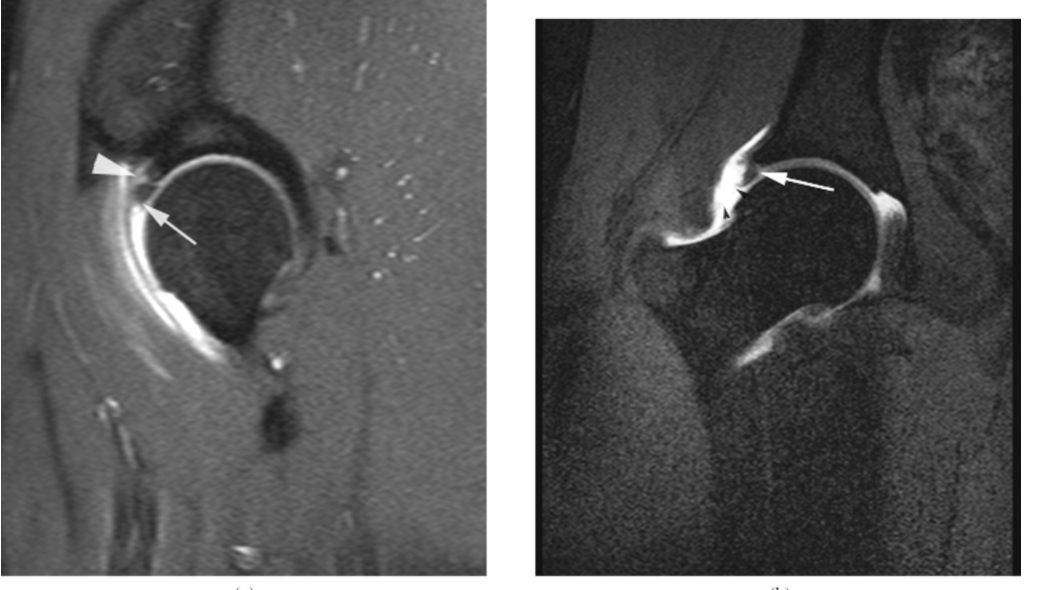Hip Labral Tear
“ I was told I have a labral tear in my hip and need surgery”
Just because your MRI says you have a labral tear, and although it may very well be the reason for you pain, this is often not the sole cause of your hip pain as there are many extraarticular and muscular causes to hip pain in the active population. As your Orthopaedic Surgeon this is my job to correctly diagnose your hip pain as your labral tear may just be an incidental finding on MRI. I will focus on the hip labrum in this month’s discussion of common hip problems.
The labrum is a fibrocartilaginous ring, like a rubber gasket, that surrounds the bony socket (acetabulum). It acts to increase the joint surface area and adds depth to the socket, thereby creating a seal for fluid lubrication and reducing contact pressures on the articular cartilage. The labrum is most commonly injured by a traumatic injury or repetitive flexion and rotation movements in activities like hockey, soccer, football, high intensity training, and gymnastics. Additionally, labral tears can result from such preexisting conditions like hip impingement, hip dysplasia, or hip arthritis. Hip impingement, otherwise known as femoro-acetabular impingement (FAI), is where the bony anatomy of the socket or the femoral head creates abnormal contact pressure and subsequently damages the labrum (please see my recent editorial on FAI). Hip dysplasia is a congenital abnormality of the hip where the hip socket is shallow from birth and the oversized labrum takes on the function of providing additional hip stability and is more prone to damage. Hip arthritis will often be associated with labral pathology and can be an absolute contraindication for surgical repair of the labrum.
The most common reason I see patients in my clinic with hip pain is for a report of a labral tear on MRI. It is normal to hear that you have a tear and assume tears need to be fixed. Let me start by saying labral pathology of the hip is very common in patients with completely unrelated other causes of hip pain. There are specific circumstances where your labral tear may require surgery, but the majority of tears can be managed appropriately with non-operative modalities like medication, injections, and physical therapy.

Labral tears are ubiquitous in the athletic population that I see. This is due to athlete’s high repetitive stress and the extra-physiologic range of motion they require of their hips. Additionally, MR images are extremely effective at visualizing hip anatomy and with the addition of contrast, otherwise known as an MRA, is highly sensitive (92%) and specific (100%) for labral tears. Care must be taken when interpreting labral tears on MRI as studies have shown a 68.1% incidence of asymptomatic labral tears in the general population and 65.4% in the athletic population. Therefore, even with a labral tear on MRI, there may be something else causing the hip pain.
I feel it is important to get a detailed history from the patient and understand what symptoms they are experiencing when dealing with labral tears. Pain deep in the groin is the most common complaint. Another location for the pain can be in the buttock for tears in different locations around the socket. The pain can also be associated with mechanical symptoms like catching, locking, or clicking. If you are experiencing these symptoms you should be evaluated by an orthopaedic surgeon who will obtain x-rays and an MRI or MRI with contrast (MRA) and surgery may be indicated. In some circumstances your surgeon will recommend an intraarticular injection of lidocaine or corticosteroid, at the time of the MRA or using ultrasound in the clinic, to assess whether your pain is coming from the torn labrum prior to recommending surgery.
If surgery is indicated due to a significant tear or a failed course of 6 weeks of conservative management, this will be done arthroscopically using two to three minimally invasive incisions (2-3mm), a small camera, and arthroscopic instruments. This procedure is a same day surgery and typically takes 30 minutes or longer depending on other coexisting problems requiring surgical attention. Most labral tears can be repaired using small 1.4 mm anchors and suture material that are permanent. Rarely does an irreparable tear need to be resected only. Multiple studies have demonstrated the importance of the suction seal effect of the labrum and its critical role in protecting the hip cartilage. In situations where the labrum is not able to be repaired, I will discuss labral reconstruction using cadaveric tissue. This procedure is technically challenging and should only be performed by surgeons with experience with this surgery. Studies have demonstrated patients undergoing labral reconstruction have significant improvement in pain, function, return to sports, avoidance of hip replacement, and high level of satisfaction.
After the surgery, the patient will not require a brace and will immediately begin ROM exercises with physical therapy in the first 24-72 hours. Weight bearing will be protected for 2 weeks only and then full weight bearing can begin. The overall time for recovery is 4-5 months depending on achieving therapy milestones.
I hope this editorial helps shed some light on the all too common recommendation for surgery due to a labral tear on MRI. The coexisting pathology associated with the presence of a labral tear is often the cause and needs to be addressed. Most labral tears in isolation can be managed without surgery, but for those tears that require surgery it is imperative the labrum is repaired and if it cannot be repaired then reconstructed.